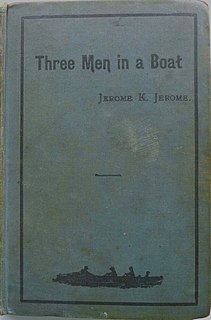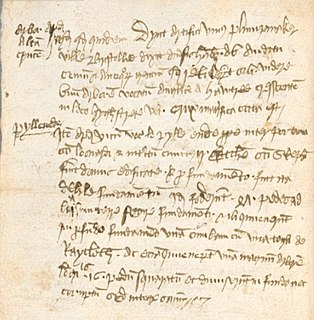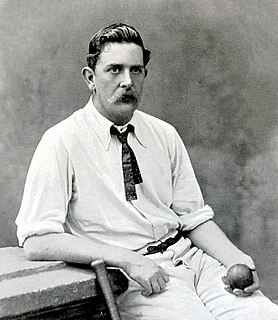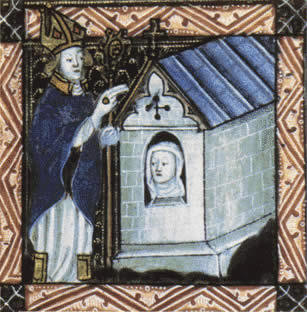
William Gilbert "W. G." Grace was an English amateur cricketer who was important in the development of the sport and is widely considered one of its greatest-ever players. Generally known as "W. G.", he played first-class cricket for a record-equalling 44 seasons, from 1865 to 1908, during which he captained England, Gloucestershire, the Gentlemen, Marylebone Cricket Club (MCC), the United South of England Eleven (USEE) and several other teams.

Walter Weedon Grossmith, better known as Weedon Grossmith, was an English writer, painter, actor, and playwright best known as co-author of The Diary of a Nobody (1892) with his brother, music hall comedian and Gilbert and Sullivan star George Grossmith. Weedon Grossmith also illustrated The Diary of a Nobody to much acclaim.

Three Men in a Boat , published in 1889, is a humorous account by English writer Jerome K. Jerome of a two-week boating holiday on the Thames from Kingston upon Thames to Oxford and back to Kingston. The book was initially intended to be a serious travel guide, with accounts of local history along the route, but the humorous elements took over to the point where the serious and somewhat sentimental passages seem a distraction to the comic novel. One of the most praised things about Three Men in a Boat is how undated it appears to modern readers – the jokes have been praised as fresh and witty.

Robert Edwin Bush was a British explorer, businessman, sportsman, and politician who was primarily known for his activities in colonial Western Australia. Arriving there in the 1870s, he was one of the settlers in the Gascoyne region and took up a number of pastoral lease. He served on the Western Australian Legislative Council from 1890 to 1893. He eventually returned to England where he was a High Sheriff of Bristol and Deputy Lieutenant of Gloucestershire.

Gloucestershire County Cricket Club is one of eighteen first-class county clubs within the domestic cricket structure of England and Wales. It represents the historic county of Gloucestershire. Founded in 1870, Gloucestershire have always been first-class and have played in every top-level domestic cricket competition in England. The club played its first senior match in 1870 and W. G. Grace was their captain. The club plays home games at the Bristol County Ground in the Bishopston area of north Bristol. A number of games are also played at the Cheltenham Cricket Festival at the College Ground, Cheltenham and matches have also been played at the Gloucester cricket festival at The King's School, Gloucester.

William Worcester, also called William Botoner was an English topographer, antiquary and chronicler.
Hugh Conway, the pen name of Frederick John Fargus, was an English novelist born in Bristol, the son of an auctioneer. He had success with his fiction in the early 1880s.

Edmund Peate was an English professional cricketer who played for Yorkshire County Cricket Club and the English cricket team.

Clifton Hampden is a village and civil parish on the north bank of the River Thames, just over 3 miles (5 km) east of Abingdon in Oxfordshire. Since 1932 the civil parish has included the village of Burcot, 1 mile (1.6 km) east of Clifton Hampden. The 2011 Census recorded the parish population as 662.

The Barley Mow is a historic public house, just south of the River Thames near the bridge at Clifton Hampden, Oxfordshire, England.

From May to September in 1878, an Australian cricket team made the inaugural first-class tour of England by a representative overseas side. In October, the Australians played additional matches in the USA and Canada on their return journey. The tour followed one made by an England team to Australia in 1876–77, during which the first matches retrospectively given Test match status were played. None of the 1878 matches had international status, nevertheless the tour proved to be such an outstanding financial and sporting success that the future of international cricket was assured.

Hugh Blair was an English musician, composer and organist.

Thomas Pardoe was a British enameler noted for flower painting.

James Arthur Bush was an English sportsman who played first-class cricket for Gloucestershire and represented England at rugby union.

William Lee Rees was an English-born New Zealand cricketer, politician and lawyer.
William Hugh Spottiswoode was an English printer, businessman and amateur cricketer.
Dr Charles Butler Grace was an English first-class cricketer who was the third-born son of W. G. Grace, considered one of the greatest cricketers of all time. He was named after Charles Butler, a Tasmanian cricketer with whom W. G. Grace had stayed in 1873-74 and who became a friend.
Joseph Hugh Brain was an English cricketer. He was educated at Clifton College and Oriel College, Oxford, and played cricket for Gloucestershire between 1883 and 1889.

Lucy de Newchurch was an anchoress from the diocese of Hereford who lived in a chapel dedicated to St. Brendan on Brandon Hill in Bristol and who later became of interest to antiquarians, historians of Bristol, and writers of Bristol guide books. She was the first known of four hermits who lived on Brandon Hill at various times between 1314 and 1480.
James William Arrowsmith was Bristolian business leader who played a key role in the erection of a statue to Edward Colston in Bristol. Arrowsmith owned J. W. Arrowsmith, the largest printing and publishing company in Bristol.
















